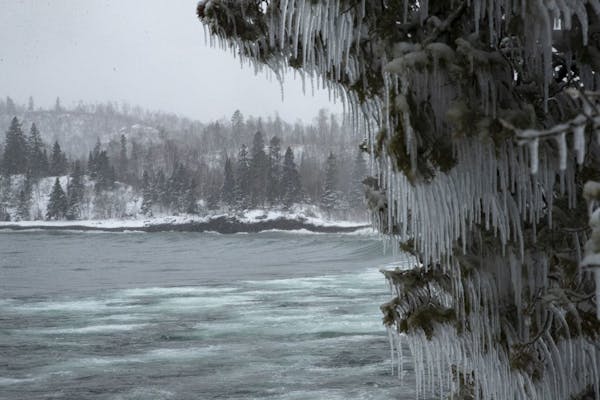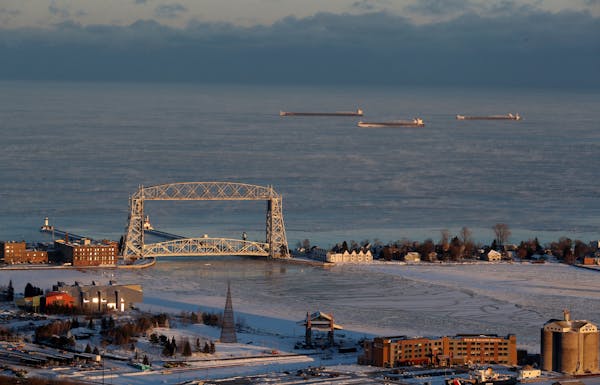TETTEGOUCHE STATE PARK, Minn. – The curious trudged to the jagged shoreline here Monday to see the stump of rock barely protruding from Lake Superior's surface, the great lake's waves lapping and swirling and sometimes hiding it altogether.
More proof, as the adage says, that nothing in this world is permanent.
A once highly photographed spire of volcanic rock lay toppled underwater, a casualty of a powerful weekend storm. Thanks to Mother Nature, the popular North Shore sea stack is gone for good.
"It's kind of sad … because it was a destination," said Christian Dalbec, a Two Harbors photographer who specializes in photographing waves from in the lake. But, he said, "you can't get too hung up on it. It's nature. That's what will happen. The lake is going to change things."
While news of the rock's collapse came as a surprise when park crews clocked in to work Sunday morning, interpretive naturalist Kurt Mead knew it really was a matter of time before it happened. Like the rest of the North Shore, the rock, estimated at 15 to 20 feet high and 8 feet around, has been slowly eroding.
Less than a decade ago, an arch of rock connected the stack's top to a peninsula on the mainland. It broke off and fell in 2010.
And nearly a century ago, just a small hole existed between the stack and the rest of the shore, with daylight showing only at the rock's base.
Over time, the waves and wind that erode the lakeshore created the arch and then slowly picked away at it until it toppled, Mead explained.
"It's been weathering the whole time. The same forces that made it are the same forces that brought it down," Mead said. "I guess it's not surprising that it eventually would fall down because it was kind of a precarious geological structure. … Think of a big three-dimensional puzzle all put together with cracks … everything sort of interlocking, holding together."
The rock there and on other parts of the shore was somehow rotated so its fractures are vertical instead of horizontal, said John Green, a geology professor emeritus at the University of Minnesota Duluth. That makes it more susceptible to erosion, he said, allowing the lake's waves to create cliffs along the shoreline.
Photographs of the tree-topped tower started to gain traction on social media about a year ago, Mead said. Some photographers looking for the perfect angle hopped over a fence to walk to the end of the peninsula to get a close shot of it, frozen with lake spray and perfectly aligned with the winter sun.
Photograph after photograph appeared on Instagram and other internet platforms.
"Things just catch on," Mead said, shrugging his shoulders.
But getting to the top of the peninsula was slippery and dangerous. Some photographers used crampons and even harnesses to keep themselves from falling off the cliff. Others photographed it more safely from shore.
"It wasn't very far from the parking lot," said Bryan Hansel, a photo workshop instructor who lives up the shore in Grand Marais. But Hansel cringed at the thought of photographers risking their safety amid giant waves and icy footing on the peninsula, bent on getting the best shot. It seemed only a matter of time before someone got hurt, he said.
"I'm sad to see a nice photographic feature disappear," Hansel said. But, he added, "because it was combined with that danger, I feel sort of a relief about it."
Photographers will find other subjects, Hansel and others said. Or shoot the peninsula in other ways.
By Monday morning, Dalbec had put on his wet suit to find the toppled rock's remains under the inland sea. He posted photographs of its remains on Instagram, titling it "Change in View." He wrote that the Tettegouche Stack is "not gone. You just can't see it without diving under water."
"It's a change," Dalbec said later. "Now it's different."
MOST-READ STORIES FROM DULUTH-SUPERIOR AREA
- Duluth's most expensive listing is $1.8M home designed for entertaining
- Behind Bentleyville: Duluth's big draw comes to light
- An essential guide to drinking along Minnesota's North Shore

Want to share info with the Star Tribune? How to do it securely

'Safe recovery sites' would offer syringes, naloxone and more to people using drugs. The plan could be in peril.
New Minnesota GOP leaders seek peace with party's anti-establishment wing

Who is Republican Lisa Demuth, Minnesota's first House speaker of color?



